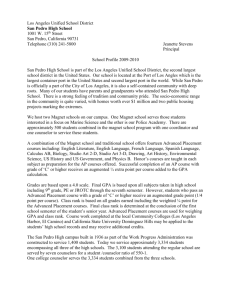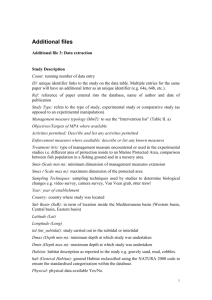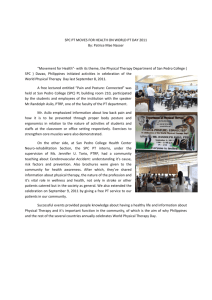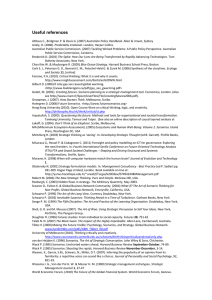Alternative Futures for Landscapes in the
advertisement
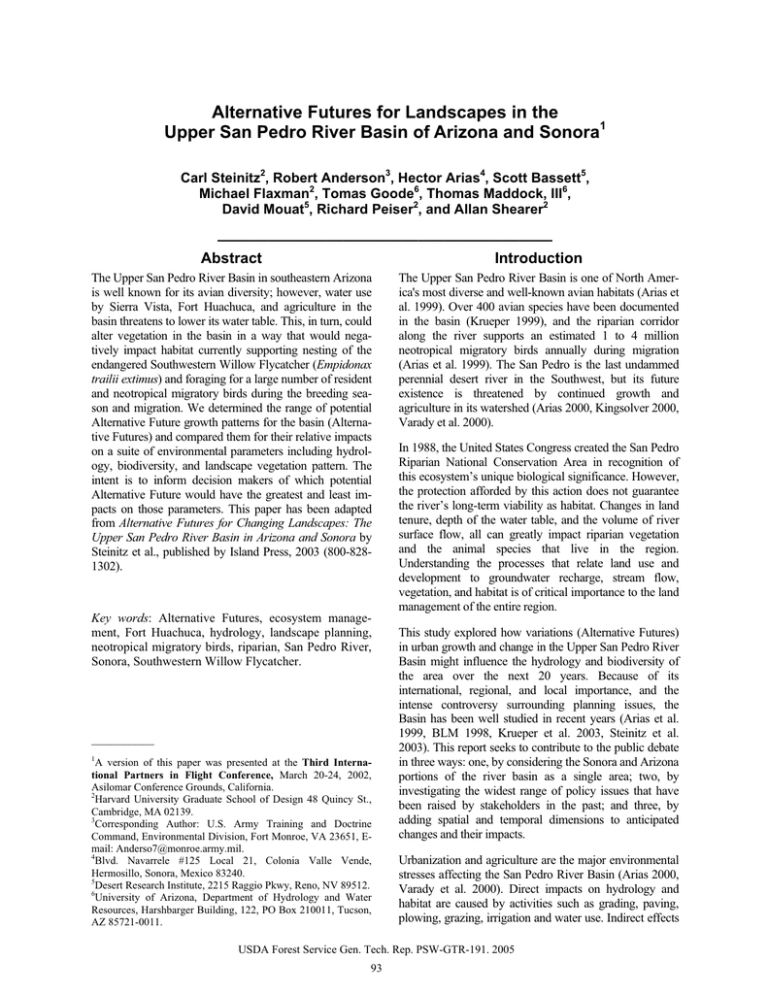
Alternative Futures for Landscapes in the Upper San Pedro River Basin of Arizona and Sonora1 Carl Steinitz2, Robert Anderson3, Hector Arias4, Scott Bassett5, Michael Flaxman2, Tomas Goode6, Thomas Maddock, III6, David Mouat5, Richard Peiser2, and Allan Shearer2 ________________________________________ Abstract Introduction The Upper San Pedro River Basin in southeastern Arizona is well known for its avian diversity; however, water use by Sierra Vista, Fort Huachuca, and agriculture in the basin threatens to lower its water table. This, in turn, could alter vegetation in the basin in a way that would negatively impact habitat currently supporting nesting of the endangered Southwestern Willow Flycatcher (Empidonax trailii extimus) and foraging for a large number of resident and neotropical migratory birds during the breeding season and migration. We determined the range of potential Alternative Future growth patterns for the basin (Alternative Futures) and compared them for their relative impacts on a suite of environmental parameters including hydrology, biodiversity, and landscape vegetation pattern. The intent is to inform decision makers of which potential Alternative Future would have the greatest and least impacts on those parameters. This paper has been adapted from Alternative Futures for Changing Landscapes: The Upper San Pedro River Basin in Arizona and Sonora by Steinitz et al., published by Island Press, 2003 (800-8281302). The Upper San Pedro River Basin is one of North America's most diverse and well-known avian habitats (Arias et al. 1999). Over 400 avian species have been documented in the basin (Krueper 1999), and the riparian corridor along the river supports an estimated 1 to 4 million neotropical migratory birds annually during migration (Arias et al. 1999). The San Pedro is the last undammed perennial desert river in the Southwest, but its future existence is threatened by continued growth and agriculture in its watershed (Arias 2000, Kingsolver 2000, Varady et al. 2000). Key words: Alternative Futures, ecosystem management, Fort Huachuca, hydrology, landscape planning, neotropical migratory birds, riparian, San Pedro River, Sonora, Southwestern Willow Flycatcher. __________ 1 A version of this paper was presented at the Third International Partners in Flight Conference, March 20-24, 2002, Asilomar Conference Grounds, California. 2 Harvard University Graduate School of Design 48 Quincy St., Cambridge, MA 02139. 3 Corresponding Author: U.S. Army Training and Doctrine Command, Environmental Division, Fort Monroe, VA 23651, Email: Anderso7@monroe.army.mil. 4 Blvd. Navarrele #125 Local 21, Colonia Valle Vende, Hermosillo, Sonora, Mexico 83240. 5 Desert Research Institute, 2215 Raggio Pkwy, Reno, NV 89512. 6 University of Arizona, Department of Hydrology and Water Resources, Harshbarger Building, 122, PO Box 210011, Tucson, AZ 85721-0011. In 1988, the United States Congress created the San Pedro Riparian National Conservation Area in recognition of this ecosystem’s unique biological significance. However, the protection afforded by this action does not guarantee the river’s long-term viability as habitat. Changes in land tenure, depth of the water table, and the volume of river surface flow, all can greatly impact riparian vegetation and the animal species that live in the region. Understanding the processes that relate land use and development to groundwater recharge, stream flow, vegetation, and habitat is of critical importance to the land management of the entire region. This study explored how variations (Alternative Futures) in urban growth and change in the Upper San Pedro River Basin might influence the hydrology and biodiversity of the area over the next 20 years. Because of its international, regional, and local importance, and the intense controversy surrounding planning issues, the Basin has been well studied in recent years (Arias et al. 1999, BLM 1998, Krueper et al. 2003, Steinitz et al. 2003). This report seeks to contribute to the public debate in three ways: one, by considering the Sonora and Arizona portions of the river basin as a single area; two, by investigating the widest range of policy issues that have been raised by stakeholders in the past; and three, by adding spatial and temporal dimensions to anticipated changes and their impacts. Urbanization and agriculture are the major environmental stresses affecting the San Pedro River Basin (Arias 2000, Varady et al. 2000). Direct impacts on hydrology and habitat are caused by activities such as grading, paving, plowing, grazing, irrigation and water use. Indirect effects USDA Forest Service Gen. Tech. Rep. PSW-GTR-191. 2005 93 Alternative Futures, San Pedro River Basin – Steinitz et al. grazing management practices. Predictions of new vegetation patterns then formed the basis for a threepart assessment of regional biodiversity: a landscape ecological pattern model, a Southwestern Willow Flycatcher habitat model (among other species in a larger study), and a vertebrate species richness model. include modified hydrology, fire suppression and vegetation change. Indirect effects may remain unnoticed by the casual observer, but their cumulative effects can be as detrimental to biodiversity as the direct impacts. Both direct and indirect impacts were assessed, with each impact assessment revealing one aspect of how an Alternative Future was predicted to change the landscape. Because no single vision of the future can be certain, it is preferable to consider several Alternative Futures that encompass a spectrum of possibilities. Therefore, this study generated several variations of each Alternative Future (scenarios) and examined the resulting range of Alternative Futures that the region might experience. The models were used to assess the potential impact of each of the Alternative Futures and their scenarios relative to the 2000 baseline conditions. To help generate the scenarios in Arizona, we developed a questionnaire for local citizens based on three issues currently being considered that are central to public debate in the region: development, water use, and land management. The answers, interpreted into a set of assumptions and choices about policy, became the range of future scenarios. A similar set of questions regarding Sonora was submitted to the Mexican population of the basin. The input provided three basic future scenarios—Planned, Constrained, and Open—that were projected to 2020 via a development model. We then varied each main scenario two or three times to test outcome comparisons. None of the scenarios considered the impact of treated effluent and storm water recharge projects proposed by the city and Fort. Study Area The study area included the Upper San Pedro River Basin from its headwaters near Cananea, Sonora, northward 187.8 km to Redington, Arizona. Adjacent areas necessary for the maintenance of regional biodiversity also were included. In total, the analysis covers 10,660 km2, centered on the northward-flowing San Pedro River. The Upper San Pedro River Basin is a transition area between the Sonoran and Chihuahuan deserts and is internationally recognized for its biodiversity. It supports the second highest land mammal diversity in the world (Arias et al. 1999), and it provides breeding habitat for more than 100 bird species (Krueper et al. 2003) and foraging or winter habitat for over 250 more (Krueper 1999). Elevations range from 900 to 2,900 meters, and annual rainfall averages 300 to 750 mm. Vegetation types include Chihuahuan and Sonoran desert scrub, semi-desert grassland, oak-woodland savanna, mesquite woodland, riparian forest, and coniferous forest. Because the watershed lies partly in Sonora and partly in Arizona, it is subject to widely different laws, regulations, and land-use practices. The Planned scenario was based on the interpretation of existing planning documents and land-use practices of the region. It assumed: (1) a population increase as currently forecast of 95,000 by 2020; (2) 80 percent of the population would be in urban homes, 15 percent in suburban, 5 percent in rural; (3) Fort Huachuca retained its current size, and growth in Sonora was moderate; (4) domestic per capita water consumption decreased 20 per cent from public and water company sources and 40 percent for individually owned sources; (5) irrigation within one mile of the river was prohibited and ranching within the basin’s public lands was prohibited; (6) unprotected areas along the river between the National Conservation Area and Mexican border were purchased for conservation, and large natural patches (>5,000 acres) and connecting natural corridors were protected; (7) potential habitat for threatened and endangered species was protected; and (8) basin scale GAPS (from Arizona Gap Analysis) were not protected. Gap Analysis overlays maps of land cover and species occurrence onto maps of protected areas using GIS technology. The resulting maps show the relationship between areas of biological significance and the level of protection afforded these areas. Methods To represent the dynamic processes at work in the study area, a computer based Geographic Information System (GIS) was used to organize spatially explicit and publicly available data for the region. The database was derived from available information on conditions in the study area during 1997 to 2000 (hereafter 2000), which defines the reference period against which impacts of future change were measured. We used a development model to evaluate the attractiveness of available land for five kinds of development: commercial, urban, suburban, exurban (between suburban and rural), and rural housing. It then simulated the urbanization of the region under different future scenarios. These were linked to a suite of process models to describe and evaluate how certain aspects of the landscape were affected under each scenario. A hydrological model evaluated changes in head configuration, loss of groundwater storage, stream capture volume, and surface flows in the San Pedro River. A vegetation model responded to changes in the hydrologic regime, combined with changes in fire and USDA Forest Service Gen. Tech. Rep. PSW-GTR-191. 2005 94 Alternative Futures, San Pedro River Basin – Steinitz et al. Three variations of the Planned scenario were tested: Test 1 – Planned compared to Planned-1 doubled the projected population growth in the Arizona portion of the basin. Test 2 – Planned compared to Planned-2 projected increased growth in Sonora, doubling the size of Cananea and its associated mining. Test 3 – Planned compared to Planned-3 compared the current plans with policies that concentrated development in the four current population centers: Sierra Vista, Benson, Tombstone, and Bisbee, and discouraged it in rural and exurban areas. Growth was directed mainly by the provision of infrastructure in advance of development. The second scenario, Constrained, investigates lowerthan-forecast population growth and tightly controlled development zones. It assumed: (1) a 50 percent smaller population than the currently forecast 78,500 by 2020; (2) 90 percent lived-in urban homes, 10 percent in rural; (3) Fort Huachuca remained open but was reduced significantly to approximately 1500 personnel; (4) domestic per capita water consumption decreased by 20 percent for all users; (5) elimination of all irrigated agriculture and ranching on state lands in the basin; (6) unprotected areas from the S.P.R.N.C.A to the Mexican border were purchased for conservation, Mexico managed an extension of the S.P.R.N.C.A., and large habitat patches (>5,000 acres) and connecting natural corridors were protected; (7) potential habitat for threatened and endangered species was protected; and (8) basin scale GAPs were protected. Two variations of the Constrained scenario were tested against each other: Test 4 – Constrained compared to Constrained-1 assessed the effect of doubling the Fort’s population while constraining off-post development. Test 5 – Constrained compared to Constrained-2 assessed the effects of closing Fort Huachuca and dividing its land between conservation and development. Since Constrained-2 had the lowest population forecast, it was expected to have the least impact on hydrology and habitats. However, it increased attractiveness for development due to the newly available land on the Fort and, therefore, also continued to lower the water table. (Closure of the Fort would likely result in protection for large portions of the Fort’s undeveloped land.) The third scenario, Open, anticipated greater than forecast population growth and low-density development across the region. It assumed: (1) the population increased to 115,000 by 2020, 50 percent more than currently forecast; (2) 60 percent of the population lived in rural homes, 15 percent in urban, 15 percent in suburban, and 10 percent in exurban; (3) Fort Huachuca was closed and all its facilities and land were used for economic growth; growth in Sonora was moderate; (4) domestic per capita water consumption remained at 1995 levels; (5) an irrigation non-expansion area in the basin was created; existing irrigation continued, but proposed irrigation within one mile of the river was prohibited; (6) ranching in the basin continued at current levels, and leasing of state land for conservation was not allowed; (7) areas along the river south of the National Conservation Area to Mexico were purchased for conservation; and (8) potential habitat for endangered but not other species was protected, and no areas were protected for species diversity or GAPs based on Arizona GAP Analysis. Two variations of the Open scenario were tested against each other: Test 6 – Open compared to Open-1 assessed the effects of closing most of Fort Huachuca when development controls were reduced and population growth in the area was higher than forecast. Open-1 increased the attractiveness for development because of the newly available increase in land. Under the Open-1 scenario, the minimum exurban lot size was increased to 16 ha. Test 7 – Open compared to Open-2 assessed the effects of the highest population growth when development controls were reduced. Populations for the Arizona portion and the Fort doubled, and Sonora experienced high growth as Cananea doubled in population. This produced the greatest level of groundwater depletion. Results Applying the process models to the scenarios for 2020 and comparing the results with the reference period (2000) yields impact assessments. The three Open scenarios were the most attractive to development. They provide the largest area of developable land from which to choose, resulting in lower land prices and housing costs. They also had the greatest negative impact on groundwater storage and recharge, substantially accelerated the drying of the San Pedro River, increased vegetation loss, and reduced all of the measures of potential wildlife habitat and visual quality. The Open scenarios resulted in a diffuse pattern of development, and the lowest level of environmental sustainability. The three Constrained scenarios, which directed most future development into existing developed areas, substantially reduced attractiveness for developers. These scenarios could alter current development practices, but were dependent upon changes in the nature of the housing market. They had the lowest negative hydro- USDA Forest Service Gen. Tech. Rep. PSW-GTR-191. 2005 95 Alternative Futures, San Pedro River Basin – Steinitz et al. Test 2 — Planned compared to Planned-2. Because of increased groundwater pumping and water use in Sonora, the rate of lowering of the water table increased. Loss of groundwater storage after 20 years was 9,100 acrefeet/year more than for Planned (table 1). These impacts would be experienced in Arizona by irrigators as well as in Sonora by ranchers. However, the hydrological impacts due to Sonora were small relative to the potential for impacts from Arizona users due to water-use policy choices in that state. Changes in ecological characteristics were similar to the first test. logical impacts, reducing the rate of loss of groundwater. The Constrained scenarios also resulted in the least loss or greatest gains in habitat types, and in the least harmful impacts on visual quality. This could improve species diversity in the region, and benefit those species that depend on this habitat such as the Southwestern Willow Flycatcher. The four Planned scenarios’ impacts were between those of the Open and Constrained scenarios, but were closer to the latter. The Planned scenarios were attractive to developers, except where urban development is limited to land within current sewer service areas. They resulted in reduced loss of groundwater, but the water table continued to lower. Planned scenarios caused environmental and visual impacts that generally represented a slow decline in several important qualities of the region. Test 3 — Planned compared to Planned-3. The policy to concentrate development in existing population centers had hydrological and other environmental advantages. Development zones improved attractiveness for urban and suburban development because of available infrastructure. They also reduced the attractiveness for rural development by reducing the amount of available land. The problem of compensation for development rights was not addressed. Regionally significant impacts included a small 0.7 percent increase in area for large habitat patches, but a sizeable 206 percent increase (3,100 to 6,400 ha) in Southwestern Willow Flycatcher habitat compared to Planned (table 2). The impacts caused by variations in specific assumptions and policies within the scenarios were tested by comparison of selected scenarios. In all cases, the impact assessments were made from a regional perspective, but were also shown with locally varied impacts in maps accompanying the broader study (Steinitz et al. 2003). Test 1 — Planned compared to Planned-1. Despite the policy assumption of reduced municipal and industrial water demand per capita, the increased population in Planned-1 overwhelmed the assumed water savings. The loss of groundwater storage over 20 years increased from 22,600 acre-feet/year to 27,300 acre-feet/year, and the water captured from the river over 20 years increased from 27,600 m3/day to 30,100 m3 /day (table 1). There were reductions in large natural habitat patches (>5,000 acres) and Southwestern Willow Flycatcher habitat of 0.9 and 6.5 percent, respectively (table 2). Test 4 — Constrained compared to Constrained-1. The hypothetical doubling of the Fort’s population had adverse but minor impacts on groundwater. There was a 10 percent increase in loss of groundwater storage, but only a little more than 1 percent increase in capture from the river (table 1). The Constrained scenario showed a 71 percent increase in flycatcher habitat over the 2000 baseline, and doubling the Fort’s population did not change this. There were small decreases in large habitat patches from the baseline of 0.6 percent and 2.3 percent Table 1— Changes in hydrology and vegetation under the ten scenarios. Baseline 2000 Planned Planned-1 Planned-2 Planned-3 Constrained Constrained-1 Constrained-2 Open Open-1 Open-2 Loss from groundwater storage over 20 yr (ac-ft/year) 39,000 22,600 27,300 31,700 23,400 16,600 18,250 14,100 42,100 43,600 53,300 Hydrology Change in Change in Capture Length municipal/ agricultural industrial from river of dry pumping over 20 yr pumping over over 20 yr river (km) 20 yr (m3/day) (m3/day) (m3/day) 113,000 94,600 38,300 7.7 21,000 91,900 27,600 2.6 21,000 112,500 30,100 2.6 23,700 125,400 30,200 3.4 20,600 94,000 27,300 2.6 2,300 93,200 20,900 2.6 2,300 99,800 21,200 2.6 2,300 85,600 21,100 2.6 106,800 109,700 38,100 39.5 106,800 113,800 37,500 38.0 109,900 144,600 38,300 40.8 USDA Forest Service Gen. Tech. Rep. PSW-GTR-191. 2005 96 Vegetation Change in Change in riparian grassland vegetation vegetation (ha) (ha) 9,600 372,000 12,500 325,900 12,300 325,600 12,300 325,600 12,600 326,000 13,100 326,000 13,100 326,000 13,100 326,000 7,300 321,600 7,250 321,600 7,300 321,300 Alternative Futures, San Pedro River Basin – Steinitz et al. Table 2— Changes in ecological characteristics under the ten scenarios. Landscape ecology Baseline 2000 Change in area of large patches (ha) 688,000 Single species potential habitat Change in Southwestern Change in Willow potential habitat Flycatcher for all endangered habitat (ha) species (ha) 9,600 136,300 Species richness Change in mean number vertebrate species detectable from one location over one year 167.71 Planned Planned-1 Planned-2 Planned-3 681,500 678,400 678,700 686,400 3,100 2,900 2,900 6,400 137,500 137,400 137,300 137,500 168.3 168.1 168.2 168.3 Constrained Constrained-1 Constrained-2 683,800 672,500 672,500 16,400 16,400 16,400 137,800 137,800 137,800 168.6 168.6 168.6 Open Open-1 Open-2 620,500 586,500 638,000 7,400 7,600 7,400 133,100 133,000 133,000 166.7 166.6 166.8 1 Source: Arizona Gap Analysis Program. respectively for the Constrained and Constrained-1 scenarios. The Fort and city’s proposed effluent treatment and storm water recharge projects were not included in calculating the Constrained Alternative Futures. The Fort has certified in formal consultation with the U.S. Fish and Wildlife Service that its groundwater withdrawal will be fully mitigated by 2011. Test 5 — Constrained compared to Constrained-2. Since Constrained-2 removed all agricultural pumping in the basin and had the lowest municipal pumping, it had the most favorable hydrological impacts (table 1). All Constrained scenarios resulted in similar increases in flycatcher habitat (table 2). The loss of large habitat patches was the same as Constrained-1. Even with the least hydrological impact, Constrained-2 also continued to lower the water table. However, regional storm water and effluent recharge projects now proposed were not evaluated during the 1997 to 2000 study period. Test 6 — Open compared to Open-1. Loss of groundwater storage for the Open scenario was 8 percent more than baseline, but Open-1 was greater at 11.8 percent. The Open scenario captured 0.5 percent less water from the river than baseline, and Open-1 decreased this further to 2 percent. Open-1 showed the largest adverse impact on large habitat patches of all scenarios with a decrease of 14.8 percent over the baseline, compared to 9.8 percent for the Open scenario. The riparian habitat impacts were similar: Open-1 showed a 24.5 percent decline in flycatcher habitat compared to 24 percent for Open. The decline in potential habitat for all endangered species was slightly more for Open-1, but all showed slightly less than 2.5 percent declines (table 2). Test 7 — Open compared to Open-2 assessed the impact of the largest population growth when development controls were reduced. The populations in the Arizona portion and Fort Huachuca doubled, and Sonora experienced high growth with the doubling of Cananea’s population. As anticipated, Open-2 produced the highest negative impacts on hydrology with a 36.6 percent increase in loss from groundwater storage due mainly to increased municipal and industrial water use. Capture of water from the river was the highest of all scenarios at 38,300 m3/day, even though this was similar to the 2000 baseline. Open-2 showed a 7.3 percent loss in large habitat patches compared to 9.8 percent for Open. Open-2 showed a similar reduction in flycatcher habitat compared to Open. Discussion A full understanding of the maps and tables produced by the simulation of the ten scenarios into Alternative Futures for 2020 and the seven tests of policy sensitivity is necessary before detailed strategies can be chosen, as amplified in Steinitz et al. (2003). However, there are some informative generalizations that can be made from the results shown here. The evaluation of scenarios was based on considering the following as positive impacts: slowing the decline of groundwater storage, slowing the drying of the river, retaining or improving wildlife habitats, maintaining or improving USDA Forest Service Gen. Tech. Rep. PSW-GTR-191. 2005 97 Alternative Futures, San Pedro River Basin – Steinitz et al. Figure 1— Study area showing Upper San Pedro River Basin. the Upper San Pedro Partnership, is developing a regional water management plan that shows great promise in reversing the aquifer’s decline. Not considered for the scenarios were USPP projects just now underway to infiltrate treated effluent and storm water into the water table. Follow-up efforts are needed to evaluate the impact of these projects. species richness, improving attractiveness for developers, and maintaining the beauty of the landscape. The most important findings involved the fundamental factor for life in an urbanizing desert: water. All of the scenario-generated Alternative Futures, even those that are most restrictive of population growth and water use, resulted in overall loss of groundwater storage and decreased stream flow in the San Pedro River. All scenarios resulted in a lowering of the water table near Sierra Vista and Cananea, with a severe drop in level around Sierra Vista of 10 to 15 m. However, the scenarios that most restrict irrigated agriculture resulted in water table gains to the north of St. David (on the river 10 km south of Benson, fig. 1). The San Pedro River continued to lose flow under the Open and Planned scenarios, and in the Open scenarios, the riparian habitat continued to decline. The region’s recent governmental and non-governmental organization effort, There will be an increasingly fragmented pattern of habitat patches that will cause decline in the habitat quality of the region’s landscape. This effect is particularly noticeable in alternatives that create development on and around the lower slopes of the mountains. Habitat for pronghorn (Antilocapra americana sonoriensis) declined in all the scenarios, as groundwater losses and changes in grazing and fire management caused the region’s extensive grasslands to decline. USDA Forest Service Gen. Tech. Rep. PSW-GTR-191. 2005 98 Alternative Futures, San Pedro River Basin – Steinitz et al. While the scenarios produced a generally negative set of impacts, there is considerable variation, especially between the extremes produced by the Constrained and Open scenarios. The Open scenarios resulted in an accelerated decline in all environmental impact measures. Although they included more developable land, they were not more attractive to developers due to a lack of infrastructure. The Constrained scenarios would see slower but continued lowering of the water table, a slowing of the processes of decline in the San Pedro River, and improved wildlife habitats. Because it had the lowest forecast population, Constrained-2 had the lowest impact on hydrology and habitats as expected. The Planned scenarios produced futures that lie between the other two, but were closer to the Constrained scenarios in impacts. The Planned scenarios most closely resembled the current Cochise County Plan, and the most likely 2020 projections for Sonora. Comparing all the Alternative Futures revealed that policy decisions affecting irrigated agriculture in Arizona will cause the greatest impacts on the region’s hydrology and ecology. The second most significant policy is local governmental control of development. Population growth in Arizona, with its accompanying municipal and industrial water demands, will be the second largest consumer of water in the future. It is informative to compare the two scenarios that differ most in their impacts, Constrained-2 and Open-2. Open-2 is expected to have the highest harmful impact on the hydrology and environment of the region. It had the most rapid depletion of groundwater of any of the Alternative Futures. However, comparing the hydrological impacts of all Open scenarios in table 2 revealed those for Open-2 are not much worse than impacts of other Open scenarios. This led to the conclusion that encouraging population growth and relaxing development constraints are very powerful influences on potential negative environmental impacts. Third in significance is growth policy in Sonora. The high growth assumed for Sonora in Planned-2 and Open-2 resulted in greater impacts than the lower growth scenarios. However, these differences were small when compared to the effects of agricultural and development policies in Arizona. The effect of Fort Huachuca on the region was tested by selecting one of three policy choices in each scenario. It would either continue as at present, double in size of on-base population, or be closed. Closing most of the Fort was desirable for developers because of the subsequent increase in available land. But for suburban and exurban development, attractiveness decreased because larger lot sizes under that scenario used up the best available land faster. While local consequences in Sierra Vista may be large, when taken in the context of the entire Upper San Pedro River Basin, the variation associated with Fort Huachuca is small when compared with variations caused by agriculture and urbanization in the Arizona portion of the basin. These findings were not unexpected. The projected future of the Upper San Pedro River Basin is one that will bring environmental crises closer to more people in the region. We do not propose solutions. Many people have views on the problems facing the region and on the policies that will influence change. The complex assessment of costs and benefits related to policy decisions is beyond the scope of this study. Responsibility for making the critical choices about the future of the region lies in Mexico and Sonora, and in the United States and Arizona, and with the present and future residents of the Upper San Pedro River Basin. Critical choices will be made over the next twenty years that will determine whether or not the most attractive areas—both for conservation and development—will continue to be attractive. The land allocations made in the study represent our best projections about where development is likely to occur under the various scenarios, and what some of the most important environmental impacts might be. Patterns may change depending on people’s preferences for housing, agriculture, and policy choices. If the people who live in the San Pedro Basin care deeply about preserving areas that will almost certainly be developed in the absence of protection, they must act now. Acknowledgments The authors gratefully acknowledge the cooperation of the regional planning agencies for the city of Sierra Vista and Cochise County, the multi-agency Semi-Arid Land-Surface-Atmosphere Program (SALSA) and Fort Huachuca, the Army’s Construction Engineering Research and Development Lab, and the Environmental Protection Agency’s Las Vegas Lab. The research was funded by a grant obtained by the U.S. Army Training and Doctrine Command’s Environmental Division from the Department of Defense’s Legacy Resources Management Program. Literature Cited Arias, H., J. Bredehoeft, R. Lacewell, J. Price, J. Stromberg, and G. Thomas. 1999. Sustaining and enhancing riparian migratory bird habitat on the Upper San Pedro River. Montreal, Quebec, Canada: The Commission for Environmental Cooperation (CEC). 123 p. Available from CEC. Montreal, Quebec; ISBN 2-922305-30-9. USDA Forest Service Gen. Tech. Rep. PSW-GTR-191. 2005 99 Alternative Futures, San Pedro River Basin – Steinitz et al. Arias, H. 2000. International groundwaters: The Upper San Pedro River Basin case. Natural Resources Journal 40(2): 199-221. Bureau of Land Management (BLM). 1998. The Upper San Pedro River Basin of the United States and Mexico: A resource directory and an overview of natural resources issues confronting decision-makers and natural resource managers. BLM/AZ/PT-98/021. Phoenix, AZ: Arizona Field Office, Bureau of Land Management, U.S. Department of the Interior. Kingsolver, B. 2000. The patience of a saint: San Pedro River. National Geographic 197(4): 80-97. Krueper, D. 1999. Annotated checklist of the birds of the Upper San Pedro River Valley. Tucson, AZ: Tucson Field Office, Bureau of Land Management, U.S. Department of the Interior. Krueper, D. J., J. L. Bart, and T. D. Rich. 2003. Response of breeding birds to the removal of cattle on the San Pedro River, Arizona. Conservation Biology 17(2): 607-615. Steinitz, C., H. Arias, S. Bassett, M. Flaxman, T. Goode, T. Maddock, D. Mouat, R. Peiser, and A. Shearer. 2003. Alternative futures for changing landscapes: the Upper San Pedro River Basin Arizona and Sonora. Covelo, CA: Island Press. Varady, R. G., M. Moote, and R. Merideth. 2000. Water management options for the Upper San Pedro Basin: Assessing the social and institutional landscape. Natural Resources Journal 40(2): 223-235. USDA Forest Service Gen. Tech. Rep. PSW-GTR-191. 2005 100
